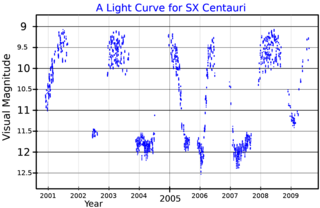
A Bayer designation is a stellar designation in which a specific star is identified by a Greek or Latin letter followed by the genitive form of its parent constellation's Latin name. The original list of Bayer designations contained 1,564 stars. The brighter stars were assigned their first systematic names by the German astronomer Johann Bayer in 1603, in his star atlas Uranometria. Bayer catalogued only a few stars too far south to be seen from Germany, but later astronomers supplemented Bayer's catalog with entries for southern constellations.
In astronomy, a variable-star designation is a unique identifier given to variable stars. It uses a variation on the Bayer designation format, with an identifying label preceding the Latin genitive of the name of the constellation in which the star lies. See List of constellations for a list of constellations and the genitive forms of their names. The identifying label can be one or two Latin letters or a V plus a number. Examples are R Coronae Borealis, YZ Ceti, V603 Aquilae.

Beta Centauri is a triple star system in the southern constellation of Centaurus. It is officially called Hadar. The Bayer designation of Beta Centauri is Latinised from β Centauri, and abbreviated Beta Cen or β Cen. The system's combined apparent visual magnitude of 0.61 makes it the second-brightest object in Centaurus and the eleventh brightest star in the night sky. According to parallax measurements from the astrometric Hipparcos satellite, the distance to this system is about 390 light-years.

A star system or stellar system is a small number of stars that orbit each other, bound by gravitational attraction. A large group of stars bound by gravitation is generally called a star cluster or galaxy, although, broadly speaking, they are also star systems. Star systems are not to be confused with planetary systems, which include planets and similar bodies.
The Bayer designation Upsilon Centauri is shared by two star systems, in the constellation Centaurus:
The Bayer designations c Centauri and C Centauri are distinct.

C1 Centauri is a single star in the southern constellation of Centaurus. It has the variable star designation V763 Centauri, while C1 Centauri is the Bayer designation. The star has a red hue and is dimly visibly to the naked eye with an apparent visual magnitude that fluctuates around +5.64. It is located at a distance of approximately 600 light years based on parallax, and has an absolute magnitude of −1.05. It is drifting further away with a radial velocity of +21 km/s. At one time it was a candidate member of the Zeta Herculis Moving Group but has since been excluded.

2 Centauri is a single star in the southern constellation of Centaurus, located approximately 183 light-years from Earth. It has the Bayer designation g Centauri; 2 Centauri is the Flamsteed designation. This object is visible to the naked eye as faint, red-hued star with an apparent visual magnitude of 4.19. It is moving away from the Earth with a heliocentric radial velocity of +41 km/s. The star is a member of the HR 1614 supercluster.
The Bayer designation Xi Centauri is shared by two star systems, in the constellation Centaurus:
3 Centauri is a triple star system in the southern constellation of Centaurus, located approximately 300 light years from the Sun. It is visible to the naked eye as a faint, blue-white hued star with a combined apparent visual magnitude of 4.32. As of 2017, the two visible components had an angular separation of 7.851″ along a position angle of 106°. The system has the Bayer designation k Centauri; 3 Centauri is the Flamsteed designation. It is a suspected eclipsing binary with a variable star designation V983 Centauri.
The Bayer designation Omicron Centauri is shared by two star systems, in the constellation Centaurus:
The designations W Centauri and w Centauri refer to two different stars in the constellation Centaurus.
The Bayer designations A Centauri and a Centauri represent different stars. Due to technical limitations, both designations link here.
The Bayer designations z Centauri and Z Centauri are distinct. Due to technical limitations, both designations link here. For the star

BV Centauri is a cataclysmic variable binary star in the constellation Centaurus. It is a dwarf nova, and undergoes rapid increases in brightness that are recurrent with a mean period of 150 days. This period seems to have increased in the last few decades. During quiescence, its visual apparent magnitude is about 13, with variations of a few tenths of magnitude over an orbit due to differences in the star's visible surface area, brightening to a maximum magnitude of 10.7 during outbursts. From its luminosity, it is estimated that the system is about 500 parsecs (1,600 ly) away from Earth. A Gaia parallax of 2.81 mas has been measured, corresponding to about 360 pc.

DY Centauri is a variable star in the constellation Centaurus. From its brightness, it is estimated to be 7000 parsecs (23000 light-years) away from Earth.

SX Centauri is a variable star in the constellation Centaurus. An RV Tauri variable, its light curve alternates between deep and shallow minima, varying its apparent magnitude from 9.1 to 12.4. From the period-luminosity relationship, it is estimated to be around 1.6 kpc from Earth. Gaia Data Release 2 gives a parallax of 0.2175 mas, corresponding to distance of about 4,600 pc.
The Bayer designations U Carinae and u Carinae are distinct. Due to technical limitations, both designations link here. For the star
The Bayer designations b Centauri and B Centauri are distinct. Due to technical limitations, both designations link here. For the star
This page is based on this
Wikipedia article Text is available under the
CC BY-SA 4.0 license; additional terms may apply.
Images, videos and audio are available under their respective licenses.







